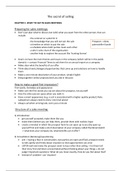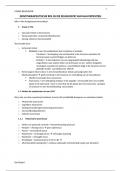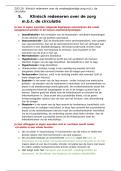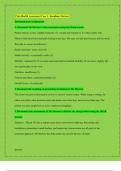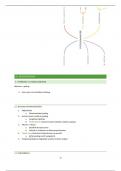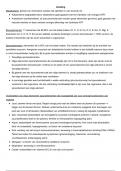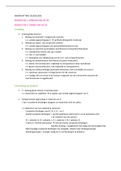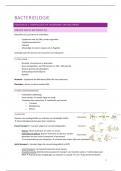CHAPTER 1: WHAT TO SAY IN SALES MEETINGS
Preparing for sales meetings:
• Don’t just plan what to discuss but ALSO what you want from the other person, that can
include:
- the contract or a pilot for it
- the knowledge that you will not win the sale Prospect = client,
- a timeline on which to put the sale potenzieller Kunde
- a schedule where both parties meet each other
- a who’s-who chart of the organisation
- another help to explore the account like ‘hunting license’
• Goal is to have the main themes and issues in the company (which will be in the public
domain) -> contact Financial Times to ask them for an annual report on a company
• Make clear what the benefits of our offer
• Think about twists/dangers/opportunities that come up and solutions on how to handle
them
• Make a one-minute description of your product, simple English
• Bring together similar projects/work you did in the past
How to make a good first impression?
First words, footsteps and appearance
• Make sure the first words you say are about the prospect, not yourself
• Give the other person space when you walk in
• Have a smart appearance (e.g. a suit is associated with a higher quality product) Rule:
salesperson always need to dress ‘one level above’
• Always call when arriving late, even just a minute
Structure of a sales meeting:
1) Introduction:
• get yourself accepted, make them like you
• make them believe you can help them, provide them with realistic hope
• create a mindset in which the prospect feels he can open up to you (by open up
yourself first and make a short description of your company called thumbnail sketch
-> what does your company do, what benefits can it offer?
2) Consultation (Beratung)/questioning
• aim = having a flow in conversation, two parties are open and fluid, prospect needs
to talk openly and freely about situation so that opportunities can arise
• LISTEN well and make the prospect want to buy rather than selling -> let them tell
their story first and listen concentrated without thinking about your things + do not
judge! Important questions: What do you mean exactly, How do you feel about that?
• Instead of ‘problem’ use ‘situation’
, • Discover the real buying motives with a GENERAL knowledge in that field, not too
specific
• Open questions start with ‘who, what, where, when, why, how’, closed ones start
with a verb e.g. ‘Do you like golf?’
• Build a relationship, don’t suggest a solution too early
• Write notes during the conversation (may have to submit a written proposal) - also
use a nice pen to make it look smart
3) Check questions to ensure you haven’t missed anything
• Check if you have a sound understanding of the problem/situation
• Like ‘Are you absolutely sure we have covered everything? Is there anything we could
have missed?’
4) The selling (match the features to customer’s needs)
• Don’t sell the feature, sell the benefits e.g. person wants a mortgage: feature is the
debts, benefit is the house
• Features of service are harder to explain than products -> brakes on a car have
benefit of safety; a firm has specialists in technical field, benefit = specialists are
better than generalists
• Don’t expect people to know the benefits without telling them; so mention a feature
and than say ‘which means that..’
• Turn negative words into more positive ones like: amount - cost | agreement -
contract | presentation - pitch | authorize - buy | value for money - cheap | improve
- change AVOID the word ‘solution’
• Be succinct (kurz und knapp) so people get the idea fast -> put their name into the
conversation
• Deal with objections (Widerspruch) during conversation by consulting them - most
objection are taken bc the client needs time for a decision (usually false objection are
at the beginning but only once, real objections are a few times until it is fully dealt
with)
• Deal with common objections:
- firm doesn’t have skills/products -> make
arrangements like partner with another firm
- client knows better firms for that job -> leave client,
get a new prospect
- personal dislike of firm -> ensure that they like you
from the beginning
- client doesn’t want to make decisions -> get closer to
the client ask more about what he wants, etc.
- client thinks its price is too high -> negotiate, but put
the discussion of the price at the end after client
knows everything
5) Asking for the business/closing
• Verbal buying signs from client: ‘How much does it cost/When could you start?
• Visual buying signs:
, • close an issue by making small deals and not a straightforward request for work
• give them alternatives on when to start the project ‘I could arrange..for either the
18th or 24th of this month. Which suits you better?’
• show confidence ‘It looks like everything is agreed. I’ll get our team together and
they can start promptly’
• checking other parties: ‘Let me check whether that consultant is available’
• conditional close: ‘If I could do it for that price would you be happy to go ahead?’
• invitational close: ‘Why don’t we try this for a month with no strings attached?’
• make a pro and contra list with the client
• give them a copy of the agreement and give them time to sign and let it be send to
you
• Do NOT speak first after the close, let the client do
• 1. Rule = ask for the work 2. Rule = keep quiet after closing Tip 1:
Focus on the senior person,
• after meeting, use it to get into contact with other people,
the other will follow (the
ask if there’s someone else in the company you should talk to
leader)
Tip 2:
Focus on waverers
CHAPTER 2: HOW TO ASSESS THE CHARACTER OF YOUR PROSPECT
(Unentschlossener)
QUICKLY AND ACCURATELY
The need to judge others quickly and correctly:
• check for particular trait’s in persons’ character as it shows how they’ll react in situations
• first you need to see if a person is extro-or introverted and if the person is task-oriented
(be logical, objective and analytical) or people-oriented (emotional, subjective, personal)
• when you understand another person’s character you can adapt your style to suit them
By combining the two results you can place the person on this chart


